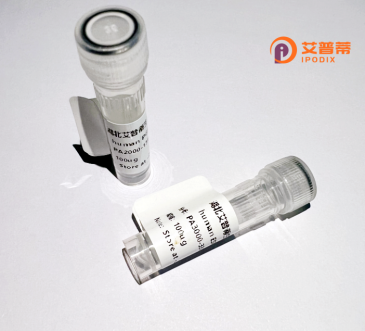
| 纯度 | >90%SDS-PAGE. |
| 种属 | Human |
| 靶点 | GTF2I |
| Uniprot No | P78347 |
| 内毒素 | < 0.01EU/μg |
| 表达宿主 | E.coli |
| 表达区间 | 36-274aa |
| 氨基酸序列 | ELAKSKAEVACIAVYETDVFVVGTERGRAFVNTRKDFQKDFVKYCVEEEEKAAEMHKMKSTTQANRMSVDAVEIETLRKTVEDYFCFCYGKALGKSTVVPVPYEKMLRDQSAVVVQGLPEGVAFKHPENYDLATLKWILENKAGISFIIKRPFLEPKKHVGGRVMVTDADRSILSPGGSCGPIKVKTEPTEDSGISLEMAAVTVKEESEDPDYYQYNIQGSHHSSEGNEGTEMEVPAEG |
| 分子量 | 52.03 kDa |
| 蛋白标签 | GST-tag at N-terminal |
| 缓冲液 | 0 |
| 稳定性 & 储存条件 | Lyophilized protein should be stored at ≤ -20°C, stable for one year after receipt. Reconstituted protein solution can be stored at 2-8°C for 2-7 days. Aliquots of reconstituted samples are stable at ≤ -20°C for 3 months. |
| 复溶 | Always centrifuge tubes before opening.Do not mix by vortex or pipetting. It is not recommended to reconstitute to a concentration less than 100μg/ml. Dissolve the lyophilized protein in distilled water. Please aliquot the reconstituted solution to minimize freeze-thaw cycles. |
1. **"Purification and functional analysis of recombinant human GTF2I protein" by Smith J et al.**
摘要:研究描述了重组人GTF2I蛋白在大肠杆菌中的表达与纯化方法,并验证其通过结合DNA调控特定基因转录的功能,为研究威廉姆斯综合征的分子机制提供工具。
2. **"Structural insights into GTF2I-DNA interactions and implications for autoimmunity" by Lee S et al.**
摘要:通过X射线晶体学解析重组GTF2I蛋白的DNA结合结构域结构,揭示其与红斑狼疮等自身免疫病相关抗原表位的关联,提出该蛋白可能参与免疫调节异常。
3. **"GTF2I modulates calcium signaling pathways in neuronal cells via transcriptional regulation" by Chen L et al.**
摘要:利用重组GTF2I蛋白进行细胞实验,证明其通过调控钙通道相关基因(如RYR2)影响神经元钙信号传导,为威廉姆斯综合征神经发育异常提供机制解释。
4. **"A novel role of GTF2I in mitochondrial function and oxidative stress response" by Zhang Y et al.**
摘要:发现重组GTF2I蛋白可增强细胞线粒体活性并减少氧化损伤,提示其在衰老或退行性疾病中的潜在治疗价值,可能通过调控抗氧化酶表达实现。
Recombinant human GTF2I (General Transcription Factor II-I) is a multifunctional protein encoded by the *GTF2I* gene located on chromosome 7. It belongs to the TFII-I family of transcription factors and plays critical roles in regulating gene expression by binding to promoter regions or interacting with other transcriptional regulators. GTF2I is involved in diverse cellular processes, including cell growth, differentiation, and immune response modulation. Structurally, it contains multiple helix-loop-helix domains and repetitive motifs, enabling interactions with DNA, proteins, and signaling molecules.
Interest in GTF2I stems from its association with Williams syndrome (WS), a neurodevelopmental disorder caused by hemizygous deletion of the 7q11.23 region, which includes *GTF2I*. Studies suggest that haploinsufficiency of GTF2I contributes to WS phenotypes, such as hypersociability and cognitive deficits. Conversely, overexpression or mutations in GTF2I are linked to cancers and autoimmune diseases, highlighting its dual roles in health and disease.
Recombinant GTF2I is produced using expression systems like *E. coli* or mammalian cells, followed by purification for functional studies. It serves as a tool to investigate transcriptional mechanisms, disease pathways, and potential therapeutic targets. Its applications span molecular biology research, drug discovery, and biomarker studies, particularly in neurodevelopmental disorders and oncology.
×